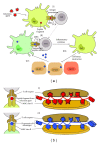Narcolepsy as an immune-mediated disease
- PMID: 24551456
- PMCID: PMC3914477
- DOI: 10.1155/2014/792687
Narcolepsy as an immune-mediated disease
Abstract
Narcolepsy is a neurological disorder characterized by excessive daytime sleepiness, cataplexy, hypnagonic hallucinations, sleep paralysis, and disturbed nocturnal sleep patterns. This disease is secondary to the specific loss of hypothalamic hypocretin (orexin)-producing neurons in the lateral hypothalamus. An autoimmune basis for the disease has long been suspected based on its strong association with the genetic marker DQB1∗06:02, and current studies greatly support this hypothesis. Narcolepsy with hypocretin deficiency is associated with human leukocyte antigen (HLA) and T cell receptor (TCR) polymorphisms, suggesting that an autoimmune process targets a peptide unique to hypocretin-producing neurons via specific HLA-peptide-TCR interactions. This concept has gained a lot of notoriety after the increase of childhood narcolepsy in 2010 following the 2009 H1N1 pandemic (pH1N1) in China and vaccination with Pandemrix, an adjuvanted H1N1 vaccine that was used in Scandinavia. The surge of narcolepsy cases subsequent to influenza A H1N1 infection and H1N1 vaccination suggests that processes such as molecular mimicry or bystander activation might be crucial for disease development.
Figures

Similar articles
-
The autoimmune basis of narcolepsy.Curr Opin Neurobiol. 2013 Oct;23(5):767-73. doi: 10.1016/j.conb.2013.04.013. Epub 2013 May 29. Curr Opin Neurobiol. 2013. PMID: 23725858 Free PMC article. Review.
-
Narcolepsy, autoimmunity, and influenza A H1N1 vaccination.Encephalitis. 2021 Apr;1(2):31-35. doi: 10.47936/encephalitis.2021.00010. Epub 2021 Mar 23. Encephalitis. 2021. PMID: 37469760 Free PMC article. Review.
-
Narcolepsy with hypocretin/orexin deficiency, infections and autoimmunity of the brain.Curr Opin Neurobiol. 2011 Dec;21(6):897-903. doi: 10.1016/j.conb.2011.09.003. Epub 2011 Sep 30. Curr Opin Neurobiol. 2011. PMID: 21963829 Review.
-
Genetic association, seasonal infections and autoimmune basis of narcolepsy.J Autoimmun. 2013 Jun;43:26-31. doi: 10.1016/j.jaut.2013.02.003. Epub 2013 Mar 13. J Autoimmun. 2013. PMID: 23497937 Free PMC article. Review.
-
Autoantibodies against ganglioside GM3 are associated with narcolepsy-cataplexy developing after Pandemrix vaccination against 2009 pandemic H1N1 type influenza virus.J Autoimmun. 2015 Sep;63:68-75. doi: 10.1016/j.jaut.2015.07.006. Epub 2015 Jul 27. J Autoimmun. 2015. PMID: 26227560
Cited by
-
Time to response with sodium oxybate for the treatment of excessive daytime sleepiness and cataplexy in patients with narcolepsy.J Clin Sleep Med. 2015 Apr 15;11(4):427-32. doi: 10.5664/jcsm.4598. J Clin Sleep Med. 2015. PMID: 25580605 Free PMC article. Clinical Trial.
-
Immune-mediated comorbidities in Saudi patients with narcolepsy.Nat Sci Sleep. 2019 May 3;11:35-43. doi: 10.2147/NSS.S195650. eCollection 2019. Nat Sci Sleep. 2019. PMID: 31118849 Free PMC article.
-
Sleep disorders, obesity, and aging: the role of orexin.Ageing Res Rev. 2015 Mar;20:63-73. doi: 10.1016/j.arr.2014.11.001. Epub 2014 Nov 22. Ageing Res Rev. 2015. PMID: 25462194 Free PMC article. Review.
-
A Rare Presentation of Narcolepsy With Cataplexy After Vaccines in a Genetically Susceptible Elderly Woman: A Case Report.Cureus. 2023 Jun 26;15(6):e40997. doi: 10.7759/cureus.40997. eCollection 2023 Jun. Cureus. 2023. PMID: 37503483 Free PMC article.
-
Narcolepsy-A Neuropathological Obscure Sleep Disorder: A Narrative Review of Current Literature.Brain Sci. 2022 Oct 30;12(11):1473. doi: 10.3390/brainsci12111473. Brain Sci. 2022. PMID: 36358399 Free PMC article. Review.
References
-
- Sakurai T, Amemiya A, Ishii M, et al. Orexins and orexin receptors: a family of hypothalamic neuropeptides and G protein-coupled receptors that regulate feeding behavior. Cell. 1998;92(5):573–585. - PubMed
Publication types
LinkOut - more resources
Full Text Sources
Other Literature Sources
Research Materials

